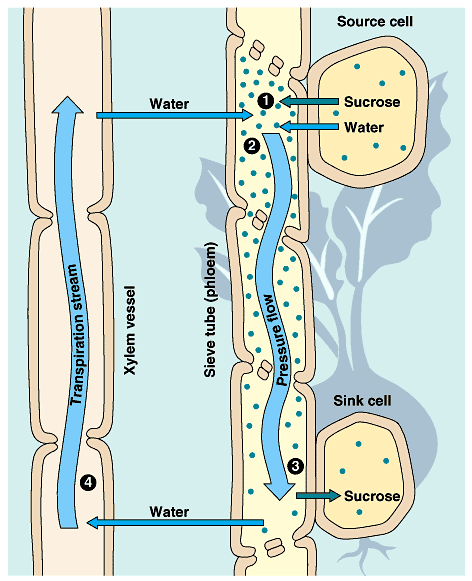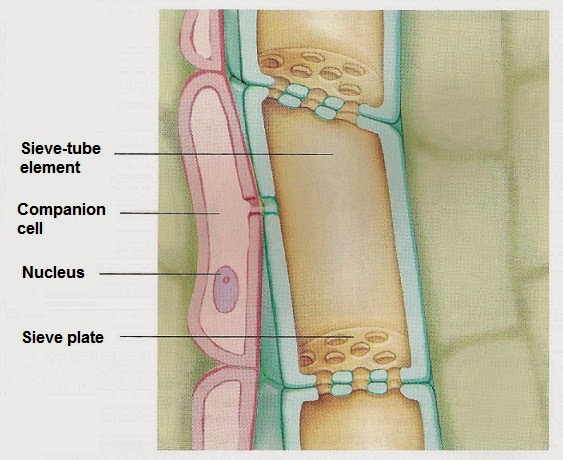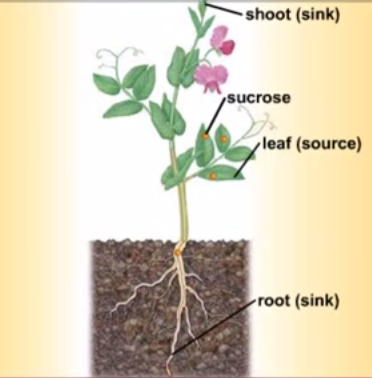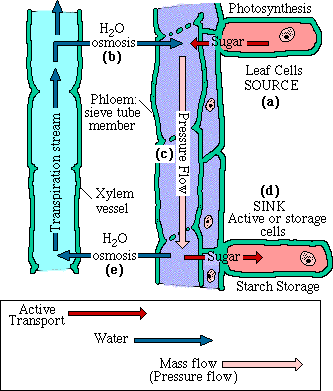Biology
 The movement of substances in phloem tissue is called translocation. The main substances that are moved are sucrose and amino acids, which are in solution in water. These substances have been made by the plant and are called assimilates.
The movement of substances in phloem tissue is called translocation. The main substances that are moved are sucrose and amino acids, which are in solution in water. These substances have been made by the plant and are called assimilates.
Phloem tissue
Phloem tissue contains cells called sieve tube elements. Unlike xylem vessel elements, these are living cells and contain cytoplasm and a few organelles but no nucleus. Their walls are made of cellulose. A companion cell is associated with each sieve tube element.


Sources and sinks

Translocation
Assimilates (sucrose and amino acids) move between sources (leaves and storage organs) and sinks ( buds, flowers, fruits, roots and storage organs) in phloem sieve tubes in a process called translocation.
The products from the source are usually translocated to the nearest sink through the phloem. The multidirectional flow of phloem contrasts the flow of xylem, which is always unidirectional (soil to leaf to atmosphere).
Translocation of sucrose and other assimilates is an energy-requiring process.
? Respiration in companion cells at a source provides ATP that is used to fuel the active transport of sucrose into the companion cell. This increases the concentration of sucrose in the companion cell, so that it moves by diffusion down a concentration gradient into the phloem sieve element.
? The increased concentration of sucrose in the companion cell and phloem sieve element produces a water potential gradient from the surrounding cells into the companion cell and phloem sieve element. Water moves down this gradient.

? At a sink, sucrose diffuses out of the phloem sieve element and down a concentration gradient into a cell that is using sucrose. This produces a water potential gradient, so water also diffuses out of the phloem sieve element.
? The addition of water at the source and the loss of water at the sink produces a higher hydrostatic pressure inside the phloem sieve element at the source than at the sink. Phloem sap therefore moves by mass flow down this pressure gradient, through the phloem sieve elements and through the sieve pores, from source to sink.

Video
- Phloem & Xylem
Are Phloem and Xylem Similar? What are the Differences? Similarities: Phloem and xylem are tissues in a plant that transport food and water. Both are vascular tissues and when they work together to effectively transport food, water and minerals they form...
- #42 Summary Of Transport In Multicellular Plants
1. Multicellular organisms with small surface area to volume ratios need transport systems. 2. Water and mineral salts are transported through a plant in xylem vessels. Movement of water is a passive process in which the water moves down a water...
- #40 Movement Of Water And Minerals In The Xylem
Most plants secure the water and minerals they need from their roots. The path taken is: soil -> roots -> stems -> leaves. The minerals (e.g., K+, Ca2+) travel dissolved in the water. Water and minerals enter the root by separate paths which...
- #39 Structure Of Transport Tissues In Plants
Plants have 2 transport systems: xylem: transports water and inorganic ions from the roots to the leaves.phloem: transports food made in the plant (sucrose and amino acids) from the leaves to the rest of the plant. Both of...
- #38.1 Transport In Multicellular Plants - Syllabus 2015
? The need for, and functioning of, a transport system in multicellular plants Learning Outcomes Candidates should be able to: (a) explain the need for transport systems in multicellular plants and animals in terms of size and surface area to...
Biology
#41 Transport In phloem

Phloem tissue
Phloem tissue contains cells called sieve tube elements. Unlike xylem vessel elements, these are living cells and contain cytoplasm and a few organelles but no nucleus. Their walls are made of cellulose. A companion cell is associated with each sieve tube element.


Vascular plants produce nutrients such as sucrose in their leaves. These nutrients must then be transported to the rest of the shoot or to the root tips, where growth occurs. The leaves are referred to as the source, and the shoot and root tips - sink.
- A source is an organ that produces more sugar than it requires. That's where assimilates enter the phloem.
- A sink is an organ that consumes sugar for its own growth and storage. That's where assimilates leave the phloem.

Translocation
Assimilates (sucrose and amino acids) move between sources (leaves and storage organs) and sinks ( buds, flowers, fruits, roots and storage organs) in phloem sieve tubes in a process called translocation.
The products from the source are usually translocated to the nearest sink through the phloem. The multidirectional flow of phloem contrasts the flow of xylem, which is always unidirectional (soil to leaf to atmosphere).
Translocation of sucrose and other assimilates is an energy-requiring process.
? Respiration in companion cells at a source provides ATP that is used to fuel the active transport of sucrose into the companion cell. This increases the concentration of sucrose in the companion cell, so that it moves by diffusion down a concentration gradient into the phloem sieve element.
? The increased concentration of sucrose in the companion cell and phloem sieve element produces a water potential gradient from the surrounding cells into the companion cell and phloem sieve element. Water moves down this gradient.

? At a sink, sucrose diffuses out of the phloem sieve element and down a concentration gradient into a cell that is using sucrose. This produces a water potential gradient, so water also diffuses out of the phloem sieve element.
? The addition of water at the source and the loss of water at the sink produces a higher hydrostatic pressure inside the phloem sieve element at the source than at the sink. Phloem sap therefore moves by mass flow down this pressure gradient, through the phloem sieve elements and through the sieve pores, from source to sink.

| Syllabus 2015 (k) explain translocation as an energy-requiring process transporting assimilates, especially sucrose, between the leaves (sources) and other parts of the plant (sinks); (l) explain the translocation of sucrose using the mass flow hypothesis; |
Syllabus 2016 7.2 Transport mechanisms Movement of xylem sap and phloem sap is by mass flow. Movement in the xylem is passive as it is driven by evaporation from the leaves; plants use energy to move substances in the phloem. Xylem sap moves in one direction from the roots to the rest of the plant. The phloem sap in a phloem sieve tube moves in one direction from the location where it is made to the location where it is used or stored. At any one time phloem sap can be moving in different directions in different sieve tubes. g) state that assimilates, such as sucrose and amino acids, move between sources (e.g. leaves and storage organs) and sinks (e.g. buds, flowers, fruits, roots and storage organs) in phloem sieve tubes h) explain how sucrose is loaded into phloem sieve tubes by companion cells using proton pumping and the co-transporter mechanism in their cell surface membranes i) explain mass flow in phloem sap down a hydrostatic pressure gradient from source to sink |
- Phloem & Xylem
Are Phloem and Xylem Similar? What are the Differences? Similarities: Phloem and xylem are tissues in a plant that transport food and water. Both are vascular tissues and when they work together to effectively transport food, water and minerals they form...
- #42 Summary Of Transport In Multicellular Plants
1. Multicellular organisms with small surface area to volume ratios need transport systems. 2. Water and mineral salts are transported through a plant in xylem vessels. Movement of water is a passive process in which the water moves down a water...
- #40 Movement Of Water And Minerals In The Xylem
Most plants secure the water and minerals they need from their roots. The path taken is: soil -> roots -> stems -> leaves. The minerals (e.g., K+, Ca2+) travel dissolved in the water. Water and minerals enter the root by separate paths which...
- #39 Structure Of Transport Tissues In Plants
Plants have 2 transport systems: xylem: transports water and inorganic ions from the roots to the leaves.phloem: transports food made in the plant (sucrose and amino acids) from the leaves to the rest of the plant. Both of...
- #38.1 Transport In Multicellular Plants - Syllabus 2015
? The need for, and functioning of, a transport system in multicellular plants Learning Outcomes Candidates should be able to: (a) explain the need for transport systems in multicellular plants and animals in terms of size and surface area to...
